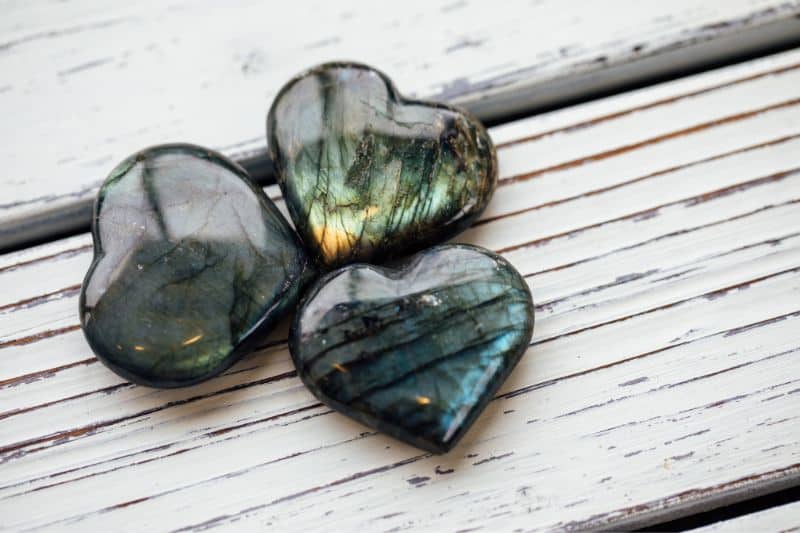Labradorite, a beautiful and mesmerizing gemstone, often raises questions among crystal enthusiasts, especially regarding its interaction with water. You might wonder if it’s safe to submerge Labradorite stone in water without causing damage. Let’s explore the properties of labradorite and its compatibility with water.
Well-known for its iridescent play of color known as labradorescence, labradorite comprises feldspar, making it a relatively hard and durable stone. However, prolonged contact with water may weaken any gemstone’s structural integrity.
Yes, labradorite can go in water as it ranks at 6-7 on the Moh’s hardness scale which means it will not dissolve in water. However, refrain from putting Labradorite for extended periods as it can cause damage to the crystal.
Read: Can Amethyst Go in Water? (And Salt Water)
Can Labradorite Go in Water?
Yes, labradorite can go in water as it ranks at 6-7 on the Moh’s hardness scale which means it will not dissolve in water. However, refrain from putting Labradorite for extended periods as it can cause damage to the crystal.
Here are some factors you should consider:
Firstly, exposing your labradorite to water briefly should not cause any harm. If you’re wearing labradorite jewelry, like a necklace or ring, washing your hands or getting caught in the rain won’t likely damage the stone. However, it is important to be cautious with prolonged exposure to water, as it may weaken the stone’s structure over time.
It’s also essential to consider the type of water the labradorite is being exposed to. While pure water is unlikely to cause damage, mineral-rich water, such as that found in pools or hot tubs, could affect the stone’s appearance. Chlorine and other chemicals in these waters may cause the labradorite’s vibrant colors to fade.
Additionally, it’s important to remember that labradorite is often set in various metals, like silver or gold. These metals may react differently to water, and prolonged exposure could cause them to tarnish or corrode.

Can Labradorite Go in Salt Water?
If you’re wondering whether you can place your labradorite gemstone in salt water, the answer is yes, you can! Labradorite is a fairly durable stone with a Mohs hardness rating of 6 to 6.5. This means it’s resistant to scratching and can generally withstand the corrosive effects of salt water.
However, taking some precautions when immersing your labradorite in salt water is essential. Make sure you don’t leave the stone in salty water for extended periods, as prolonged exposure can potentially damage the stone’s surface and cause the colorful labradorescence to fade.
When using salt water for cleansing or charging your labradorite, consider using a short soak, such as 10-15 minutes. This way, you’ll still allow your stone to absorb the positive energies from the salt water while reducing the risk of any damage.
Finally, after removing your labradorite from the salt water, rinse it with fresh water to remove any residual salt. This step can help in maintaining the luster and quality of your stone.
Can Labradorite Go in Moon Water?
Moon water is simply water that has been charged with the moon’s energy, typically during a full moon. Yes, you can safely place Labradorite in moon water but again it is not a good idea to put it for long periods.
To create your own moon water, all you need is a container, water, and a piece of Labradorite. Place the Labradorite in the container, fill it with water, and set it outside under the moonlight. Leave it there for a few hours, preferably overnight.
The Labradorite crystal will absorb the moon’s energy, thereby transferring it into the water. As a result, the moon water will carry both the moon’s mystical qualities and Labradorite’s energetic vibrations. You can then use this charged water in various rituals, spells, and self-care practices.
It’s important to note that Labradorite is a relatively soft stone, with a Mohs hardness of 6 to 6.5. However, it does not dissolve or get damaged in water. So, feel free to use it in moon water without worrying about harming the stone.
Can You Wear It While You Shower or Take a Bath?
It’s natural to wonder if you can wear your beautiful Labradorite jewelry while taking a shower or soaking in a bubble bath. Since this gemstone, like many others, can be sensitive to some cleaning products, it’s worth considering a few factors.
First, let’s understand that Labradorite is a relatively durable stone, with a hardness of 6-6.5 on the Mohs scale. This means that it is resistant to minor scratches and won’t crack easily.
However, it’s essential to remember that chemicals typically found in soaps, shampoos, and other personal care products might affect the stone’s surface.
When it comes to exposing Labradorite to water, you can rest assured that the stone itself will not be damaged simply by coming into contact with water. However, prolonged exposure to water might weaken the adhesive used in your jewelry’s settings, which could potentially cause the stone to become loose.
Wearing your Labradorite jewelry while swimming in a pool, hot tub, or the ocean should be avoided. The high levels of chlorine or salt water can affect the stone’s surface and damage its beautiful play of colors, known as labradorescence.
To ensure your Labradorite jewelry’s longevity and keep its vibrant colors and features intact, it’s best to avoid wearing it while taking a shower or a bath. Instead, take a moment to remove and safely store your jewelry before enjoying your water-based activities.
Precautions When Exposing Labradorite to Water
Labradorite is a beautiful gemstone known for its iridescent play of colors, but you might wonder if it’s safe to expose it to water. Labradorite can be submerged in water without being damaged. However, it’s important to take some precautions to maintain its beauty and durability.
Firstly, be aware that exposure to chemicals in swimming pools or hot tubs can cause harm to the stone. Chlorine and other chemicals may dull the surface, so removing jewelry with labradorite is best before entering these environments.
Next, be gentle when cleaning your labradorite. Use a soft cloth and mild soap to wipe it down, then rinse it under warm running water. Avoid using ultrasonic cleaners, high-pressure steam, or harsh chemicals, as these can damage or strip away the stone’s vibrant colors.
Temperature changes can have an impact on labradorite as well. Sudden fluctuations in temperature can cause the stone to crack or experience color changes, so make sure to avoid placing it in extremely hot or cold water.
When wearing labradorite jewelry, try not to let it come into prolonged contact with water. Although brief exposure shouldn’t cause any harm, extended periods in water can gradually weaken the stone’s structure.

Alternative Methods for Cleaning Labradorite
When it comes to cleaning your labradorite, water may not be the best option. Luckily, you can use several alternative methods to keep your labradorite clean and looking beautiful. Here, we’ll explore a few of these methods in a friendly and easy-to-understand manner.
Dry Cloth Method
This is the simplest method. All you need is a soft, dry cloth to gently wipe away any dust, dirt, or fingerprints from your labradorite. This non-abrasive approach will ensure you don’t scratch the surface, making it the perfect choice for those who like gentle techniques.
Read: Can Citrine Go in Water? (Salt Water & Bath Water)
Mild Soap and Damp Cloth
Though labradorite can be sensitive to water, you can still use a slightly damp cloth with a small amount of mild soap or detergent. Just be sure not to soak your labradorite and only use a minimum amount of water. After gently rubbing the stone with the soapy cloth, thoroughly dry it with another clean cloth to prevent water spots or potential damage.
Air Compressor or Dust-Off Spray
If you’re dealing with hard-to-reach crevices or intricate carvings in your labradorite, an air compressor or canned air like the ones used on electronics can be an innovative solution. By blowing air on your labradorite, you can easily remove accumulated dust or dirt without water.
As you can see, there are several ways to clean your labradorite without exposing it directly to water. Choose the method that best fits your needs and preferences, and your labradorite will remain as dazzling as ever.
Frequently Asked Questions
Can I place labradorite in a fish tank?
Yes, you can place labradorite in a fish tank. Labradorite is a non-toxic mineral and won’t harm your fish or affect the water quality. However, make sure to clean the stone thoroughly before placing it in the tank, as it may have dust or other residues on its surface.
Is it safe to cleanse labradorite with water?
It is safe to cleanse labradorite with water. In fact, using water is a gentle and effective way to cleanse your labradorite crystals. To do this, hold the stone under running water for a few minutes. Be sure to have a soft cloth or towel ready to pat the stone dry immediately after cleansing to avoid any water spots or damage to the stone’s surface.
Are labradorite water bottles safe?
Labradorite water bottles are generally safe to use, as labradorite is a non-toxic mineral. However, it is essential to ensure that the bottle is made from high-quality materials and that the labradorite is securely embedded to prevent any risk of it breaking or dislodging.
Can labradorite be charged with water?
Labradorite can be charged with the energies of water by placing the stone in a bowl of purified water, preferably under the light of the full moon or sun. The water element is associated with the emotional realm, so charging labradorite with water can potentially help you connect with your emotions and intuition more deeply.







